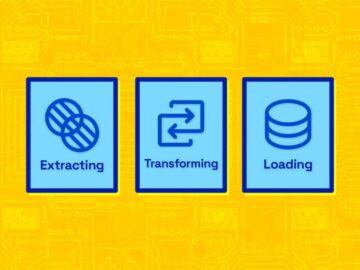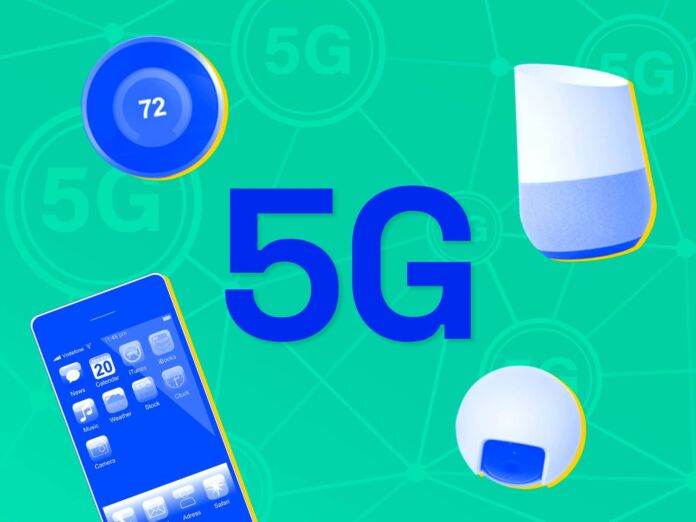
Introduction
We knew 2G for its ‘Voice & SMS’ capability, 3G for its ‘Mobile data’, and 4G for its ‘Mobile broadband’. We primarily associate all these generational mobile technologies with consumers (mobile users).
5G is the first technology that is associated with ‘Digital Transformation’. It is often called ‘Mobile Edge’ technology, the technology that will be deployed at ‘Edge’ and will enable many interesting use cases including Industry 4.0.
The three main technology enablements that 5G promises are: eMBB (Enhanced Mobile Broadband), URLLC (Ultra Reliable Low Latency Communications), and mMTC (Massive Machine type communications). All these technology enablers have a perfect use in the Digital Transformation of various industries, including Manufacturing, Healthcare, Education, Defense, Utilities, Smart Cities, etc.
The Benefits of Private 5G Networks
Private 5G networks refer to local cellular networks that are owned and operated by individual organizations, rather than relying on public cellular infrastructure provided by traditional network operators. These networks are designed to serve a specific organization or a confined geographical area.
Wi-Fi is the primary wireless technology used in industrial and other businesses today. The below chart summarizes the key differences between the 5G and WiFi 6 technology.
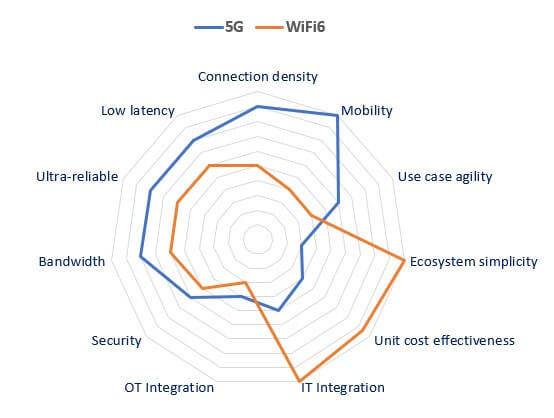
Private 5G networks offer significantly higher speeds and lower latency compared to traditional networks. This translates into faster data transfer, improved real-time communication, and seamless connectivity, enabling businesses to leverage applications that demand high performance.
With dedicated infrastructure and localized coverage, private 5G networks provide greater reliability and security. They can be optimized for mission-critical applications, ensuring uninterrupted connectivity even in challenging environments. These networks are isolated from public networks, providing an additional layer of protection against cyber threats and unauthorized access.
Private 5G networks also have the capability to handle a massive number of devices simultaneously. This is particularly crucial for applications like industrial IoT, smart cities, and autonomous vehicles, where a vast number of devices need to be connected and coordinated seamlessly.
How to Build Private 5G Networks
There are five key elements that form part of the Digital Transformation solution using private 5G.
- UE (User Equipment): It refers to the end-user device or equipment that connects to the 5G network. The UE can be any device that enables communication over the network, such as smartphones, tablets, laptops, 5G enabled Camera, IoT Gateways, 5G Modem, Fixed CPE, Plug-in UE (Dongle, Mi-Fi Devices, Video bridges), Chipset /Modules. In 5G networks SIM/eSIM is the component that acts as an identity for the UE.
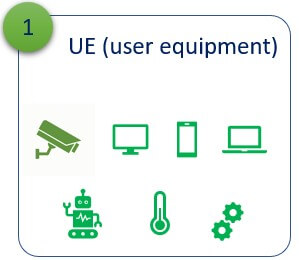
- Spectrum & SAS (Spectrum Access System): One of the key drivers enabling Private 5G deployment is the availability of Spectrum.
CBRS (Citizens Broadband Radio Service) in the U.S. was created by the Federal Communications Commission (FCC) to enable shared access to spectrum for both commercial and federal users. The CBRS band utilizes a three-tiered sharing framework to allocate spectrum resources:
- Tier 1 Incumbent Users: The highest tier consists of authorized federal and military users who are given priority access. For example, the Navy periodically uses 10-10 MHz in select locations along the coasts.
- Tier 2 Priority Access License (PAL): The second tier consists of entities that have acquired a PAL through an auction process. PAL holders have priority access to a specific portion of the CBRS spectrum in a specific geographic area.
- Tier 3 General Authorized Access (GAA): The third tier consists of unlicensed users who can access the entire 150MHz CBRS spectrum when it is not in use by incumbent or PAL holders.
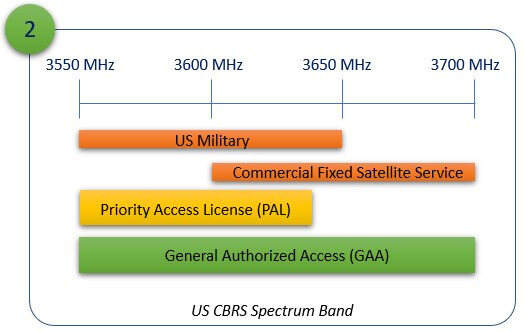
The Spectrum Access System (SAS) is responsible for managing and authorizing access to the CBRS spectrum, ensuring efficient and interference-free sharing among different users. The SAS determines the availability of spectrum in a particular geographic area and time. Based on the spectrum availability, the SAS allocates specific frequency channels or bandwidth portions to both PAL and GAA devices.
- Radio / CBSDs:
CBSD (Citizens Broadband Radio Service Devices) are the devices used to access the spectrum and provide radio coverage and capacity. They can be considered equivalent to Access Points, which radiate RF power, have antenna characteristics, and are geolocated.
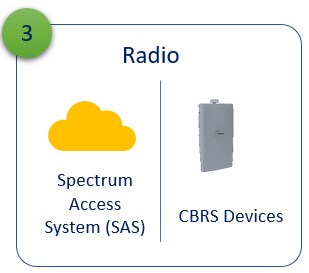
There are two categories defined:
- Category A (Indoor, Low power (Max EIRP: 30dBm, <1W/10MHz, self-installed, outdoor antenna height limited to 6m), and
- Category B (Outdoor, High Power (47 dBm/10MHz), professionally installed).
- Core Networks: They can be considered the intelligent router that also performs UE authentication. The Network Management system can also be included in the core infrastructure deployment.
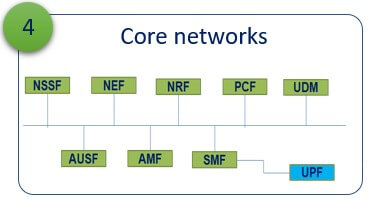
- Edge Applications: These are the ones driving the use of Private 5G networks. These applications can be AR/VR based, video analytics, ML inferencing at edge, or any other applications that will have connectivity to the UE using high-throughput, low latency Private 5G network.
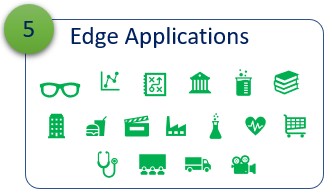
Conclusion
As the deployment of private 5G networks continues to expand, we can anticipate an era of unprecedented innovation, automation, and connectivity that will reshape industries and pave the way for a more connected future.
The below graphic shows the potential of Private 5G networks across various businesses, sectors, and industries.
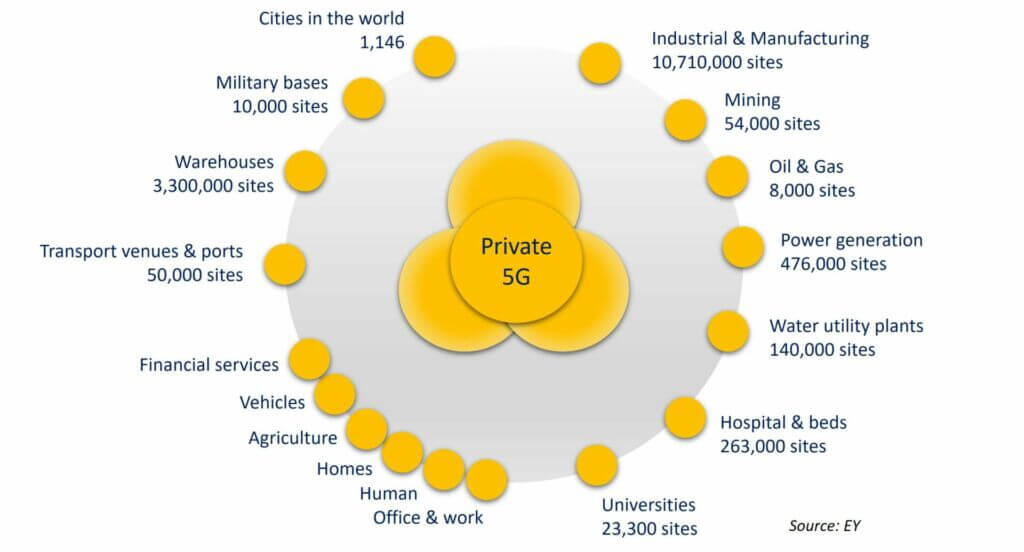
- SEO Powered Content & PR Distribution. Get Amplified Today.
- PlatoData.Network Vertical Generative Ai. Empower Yourself. Access Here.
- PlatoAiStream. Web3 Intelligence. Knowledge Amplified. Access Here.
- PlatoESG. Automotive / EVs, Carbon, CleanTech, Energy, Environment, Solar, Waste Management. Access Here.
- BlockOffsets. Modernizing Environmental Offset Ownership. Access Here.
- Source: https://www.iotforall.com/5-elements-of-building-your-private-5g-network
- :is
- :not
- :where
- 1
- 5G
- 5g network
- 5G networks
- a
- access
- acquired
- across
- acts
- Additional
- against
- All
- allocate
- allocates
- along
- also
- among
- an
- analytics
- and
- antenna
- anticipate
- any
- applications
- AR/VR
- ARE
- AREA
- AS
- Associate
- associated
- At
- Auction
- Authentication
- authorized
- Automation
- autonomous
- autonomous vehicles
- availability
- BAND
- Bandwidth
- based
- BE
- below
- benefits
- between
- both
- bridges
- broadband
- build
- Building
- businesses
- by
- called
- camera
- CAN
- capability
- Capacity
- cases
- categories
- CBRS
- cellular
- challenging
- channels
- characteristics
- Chart
- chipset
- Cities
- Citizens
- commercial
- commission
- Communication
- Communications
- compared
- component
- connected
- Connected Future
- Connectivity
- connects
- considered
- consists
- Consumers
- continues
- coordinated
- Core
- coverage
- created
- crucial
- cyber
- data
- dedicated
- Defense
- defined
- Demand
- deployed
- deployment
- designed
- determines
- device
- Devices
- differences
- different
- digital
- Digital Transformation
- drivers
- driving
- Edge
- Education
- efficient
- elements
- enable
- enabled
- enables
- enabling
- enhanced
- ensuring
- Entire
- entities
- environments
- equipment
- Equivalent
- Era
- etc
- Ether (ETH)
- Even
- example
- Expand
- faster
- FCC
- Federal
- Federal Communications Commission
- First
- five
- fixed
- For
- form
- Framework
- Frequency
- from
- future
- gateways
- General
- generational
- geographic
- geographical
- given
- greater
- handle
- Have
- healthcare
- height
- High
- higher
- highest
- holders
- HTML
- HTTPS
- Identity
- improved
- in
- included
- Including
- Incumbent
- individual
- Indoor
- industrial
- Industrial IoT
- industries
- industry
- industry 4.0
- Infrastructure
- Innovation
- installed
- Intelligent
- interesting
- into
- iot
- isolated
- IT
- ITS
- jpg
- Key
- laptops
- Latency
- layer
- Leverage
- License
- like
- Limited
- local
- locations
- Low
- lower
- machine
- Main
- management
- management system
- managing
- manufacturing
- many
- massive
- max
- max-width
- Military
- ML
- Mobile
- more
- Need
- network
- networks
- number
- of
- offer
- often
- on
- ONE
- ones
- operated
- operators
- optimized
- or
- organization
- organizations
- Other
- Outdoor
- over
- owned
- part
- particular
- particularly
- pave
- perfect
- performance
- performs
- plato
- Plato Data Intelligence
- PlatoData
- points
- potential
- power
- primarily
- primary
- priority
- private
- process
- professionally
- promises
- protection
- provide
- provided
- providing
- public
- Radio
- rather
- real-time
- refers
- reliability
- reliable
- relying
- Resources
- responsible
- router
- s
- SAS
- seamless
- seamlessly
- Second
- Sectors
- security
- serve
- service
- shared
- sharing
- Shows
- significantly
- simultaneously
- smart
- Smart Cities
- smartphones
- solution
- specific
- Spectrum
- speeds
- such
- system
- Technologies
- Technology
- than
- that
- The
- These
- they
- Third
- this
- threats
- three
- Through
- tier
- time
- to
- today
- traditional
- transfer
- Transformation
- two
- type
- u.s.
- Ultra
- unprecedented
- us
- use
- used
- User
- users
- uses
- using
- utilities
- utilizes
- various
- Vast
- Vehicles
- Video
- vs
- was
- Way..
- we
- when
- which
- WHO
- wifi
- will
- wireless
- with
- Your
- zephyrnet



